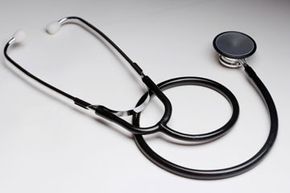Sound has been used as a diagnostic tool for millennia [source: NPR]. You can learn a lot with an ear — or the bell of a stethoscope — to a person's chest — that the heart valve isn't fully closing, for instance ("whoosh"), or that the bowel is obstructed ("gurgle"). Listen a bit lower and you can determine the size of the liver [source: IPAT].
The initial stethoscope was invented in the early 19th century by French physician René Laennec. His invention helped him hear body sounds more clearly, yes, but Laennec was actually trying to achieve a rather different end: doctor-patient distance. Hygiene in the 1800s was not what it is today, and the doctor was tired of pressing his face against dirty, smelly, lice-ridden bodies [source: NPR].
Advertisement
Laennec's stethoscope was basically a hollow tube. Other innovators created progressively more complex designs, culminating with Harvard-based doctor David Littmann's stethoscope, which is pretty much the same as the one that hangs around the necks of healthcare providers today [source: NPR]. These Littmann stethoscope models can pick up sounds as faint as fetal heart beats just six weeks into a pregnancy.
While their most common use is in detecting heart and breath sounds, they can also be crucial tools in detecting abnormalities in digestive and venous systems [source: EoS]. Stethoscopes can also be used, in conjunction with blood pressure cuffs, as part of clinical blood pressure measurement by capturing blood sounds.
How? It's actually a pretty basic approach to harnessing the properties of sound. To understand how a stethoscope conveys, say, the "lub-lub" of a heart beat from a heart to a doctor's ears, we'll start with the core components of the tool. As it turns out, there's a mere handful.
Advertisement

